 |
 |
 |
 |
 |
 |
| |
 |
|
 |
 |
 |
  |
  |
 |
 |
 |
 |
|
|
 |
|
 |
 |
 |
BUILDING |
 |
|
 |
|
 |
 |
 |
| |
 |
| 
 |
MMM Corones
Messner Mountain Museum Corones |
|
 |
 |
 |
 |
DESIGNER |
 |
|
|
 |
|
 |
 |
 |
| |
 |
|
 |
 |
 |
 |
CONTEXT |
 |
|
|
 |
|
 |
 |
 |
| The complex of the interventions |
 |
|
 |
With a central museum in Sigmundskron and five branch museums devoted to individual themes, Reinhold Messner has created a mountain museum that is truly unique. He describes the project as his “15th ascent over 8000 meters” – and makes use of it to communicate to visitors his knowledge and experience and the stories that derive from man’s encounter with the mountains.
MMM currently comprises six museums. MMM Firmian in Sigmundskron Castle near Bozen is the heart of the Mountain Museum; MMM Ortles in Sulden is devoted to the glaciers and the world of eternal ice; at MMM Dolomites on Monte Rite south of Cortina, the focus is on rock and mountain climbing in the Dolomites; MMM Juval in Juval Castle in Vinschgau relates the myths of the mountain. MMM Ripa in Bruneck Castle tells the story of the mountain peoples. In July 2015 the last MMM, MMM Corones, will open.
The Messner Mountain Museums are not conventional art or natural science museums; they have an interdisciplinary design. Each of the museums occupies a unique location, which helps relate the museum’s theme to the collections and the architecture. The geographical location, relics and works of art combine to form a whole.
|
|
 |
 |
 |
 |
 |
 |
 |
DESCRIPTION |
 |
|
|
 |
|
 |
 |
 |
| The Supreme Discipline of Mountaineering |
 |
|
 |
To what heaven would it lead me
to climb a mountain that flew?
Christoph Ransmayr, The Flying Mountain |
|
 |
 |
 |
|
 |
|
| . |
 |
|
 |
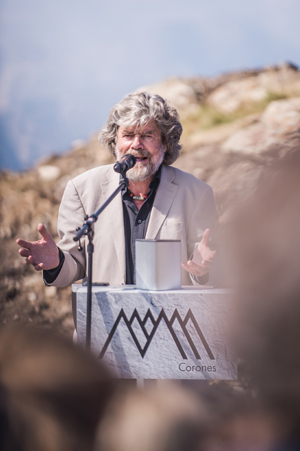 MMM Corones on Kronplatz – between the Gader Valley, Olang and the Puster Valley – is the final act in the Messner Mountain Museum project (which comprises a total of six facilities). On the edge of South Tyrol’s mountain plateau with the most spectacular views, in the unique museum architecture created by Zaha Hadid, I present the crowning of traditional mountaineering. MMM Corones on Kronplatz – between the Gader Valley, Olang and the Puster Valley – is the final act in the Messner Mountain Museum project (which comprises a total of six facilities). On the edge of South Tyrol’s mountain plateau with the most spectacular views, in the unique museum architecture created by Zaha Hadid, I present the crowning of traditional mountaineering.
 Kronplatz offers views beyond the borders of South Tyrol to all points of the compass: from the Lienz Dolomites in the east to the Ortler in the west, from the Marmolada in the south to the Zillertal Alps in the north. The museum is a mirror of the world of my childhood - the Geislerspitzen, the central buttress of the Heiligkreuzkofel (the most difficult climb in my whole life) and the glaciated granite mountains of the Ahrn Valley. On Kronplatz I present the development of modern mountaineering and 250 years of progress with regard to the equipment. I speak of triumphs and tragedies on the world’s most famous peaks – the Matterhorn, Cerro Torre, K2 – and the depiction of our activity, however contradictory it may seem. As in my other museums, I shed light on alpinism with the help of relics, thoughts, works of art (pictures and sculptures) and by reflecting the outside mountain backcloth in the interior of MMM Corones. Kronplatz offers views beyond the borders of South Tyrol to all points of the compass: from the Lienz Dolomites in the east to the Ortler in the west, from the Marmolada in the south to the Zillertal Alps in the north. The museum is a mirror of the world of my childhood - the Geislerspitzen, the central buttress of the Heiligkreuzkofel (the most difficult climb in my whole life) and the glaciated granite mountains of the Ahrn Valley. On Kronplatz I present the development of modern mountaineering and 250 years of progress with regard to the equipment. I speak of triumphs and tragedies on the world’s most famous peaks – the Matterhorn, Cerro Torre, K2 – and the depiction of our activity, however contradictory it may seem. As in my other museums, I shed light on alpinism with the help of relics, thoughts, works of art (pictures and sculptures) and by reflecting the outside mountain backcloth in the interior of MMM Corones.
As the storyteller of traditional mountaineering, it is not my intention to judge or dramatise but simply to condense human experience of a world that is my world, of the 250-year-old contest between man and the mountain. The focus is not on sport and records but on people, on the key contributors to mountaineering, including philosophers and pioneers who had the courage to take the ‘golden step’ from the idea to the deed, disregarding the question “Why?”
“Corones” is the Ladin word for “crown”, like “Krone” in German. And Kronplatz – South Tyrol’s famous mountain for skiers and hikers and a perfect launchpad for hang-gliders and paragliders – is now home to the crowning piece of my mountain museum project, a place of quiet where people can slow down and enjoy unforgettable views. It is a place of withdrawal that opens up the human senses for the above and beyond, where the mountains become an experiential space and a part of our culture. In mental flights beyond all summits, they are revealed anew.
Reinhold Messner |
|
 |
 |
 |
|
 |
|
| . |
 |
|
 |
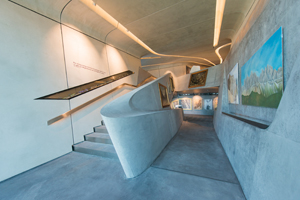 The architecture is unique. Walls, ceilings, and also architectural elements that are visible from the outside, such as the entry area, the panorama terrace and the panorama windows, are being encased with special ready-made concrete sections through the use of specially provided metal subconstructions. The architecture is unique. Walls, ceilings, and also architectural elements that are visible from the outside, such as the entry area, the panorama terrace and the panorama windows, are being encased with special ready-made concrete sections through the use of specially provided metal subconstructions.
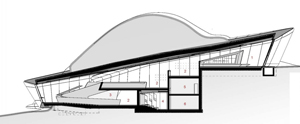 The topmost level houses the entry area with the cashiers, a small museum shop, and the check room along with lockers. From there, stairways lead like waterfalls over three exhibition levels all the way to the bottom. A central exhibition space as the main focus of the museum offers room for larger exhibits and presentations. The topmost level houses the entry area with the cashiers, a small museum shop, and the check room along with lockers. From there, stairways lead like waterfalls over three exhibition levels all the way to the bottom. A central exhibition space as the main focus of the museum offers room for larger exhibits and presentations.
At the lowest floor, visitors on their tour pass by glass-enclosed viewing windows and arrive at a terrace that is nearly 40 square meters (430 square feet), from which they are able to enjoy a lovely 240°panorama from the Zillertal Alps to the Ortles-Ortler to the Dolomites. In this way, a reference is created between the mountain world outside and the theme of the museum, the great faces as the royal discipline of mountaineering. There is also a cinema with around twenty seats. |
|
 |
 |
 |
|
 |
|
| . |
 |
|
 |
|
 |
 |
 |
|
 |
|
| . |
 |
|
 |
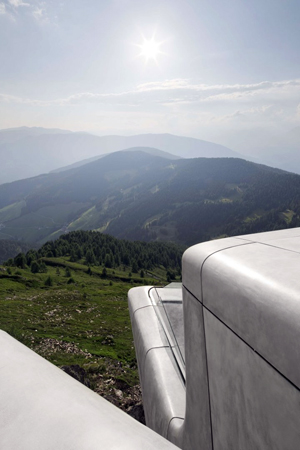 Messner, the first person to climb all 14 mountains around the world over 8,000 meters, and the first to climb Mount Everest without the aid of tanked oxygen, conveys his vision for the MMM Corones: “Kronplatz offers views beyond the borders of South Tyrol to all points of the compass: from the Lienz Dolomites in the east to the Ortler in the west, from the Marmolada Glacier in the south to the Zillertal Alps in the north. The museum is a mirror of the world of my childhood – the Geislerspitzen, the central buttress of the Heiligkreuzkofel (the most difficult climb in my whole life) and the glaciated granite mountains of the Ahrn Valley. On Kronplatz I present the development of modern mountaineering and 250 years of progress with regard to the equipment. I speak of triumphs and tragedies on the world’s most famous peaks – the Matterhorn, Cerro Torre, K2, and shed light on alpinism with the help of relics, thoughts, works of art and by reflecting the outside mountain backcloth in the interior of MMM Corones.” Messner, the first person to climb all 14 mountains around the world over 8,000 meters, and the first to climb Mount Everest without the aid of tanked oxygen, conveys his vision for the MMM Corones: “Kronplatz offers views beyond the borders of South Tyrol to all points of the compass: from the Lienz Dolomites in the east to the Ortler in the west, from the Marmolada Glacier in the south to the Zillertal Alps in the north. The museum is a mirror of the world of my childhood – the Geislerspitzen, the central buttress of the Heiligkreuzkofel (the most difficult climb in my whole life) and the glaciated granite mountains of the Ahrn Valley. On Kronplatz I present the development of modern mountaineering and 250 years of progress with regard to the equipment. I speak of triumphs and tragedies on the world’s most famous peaks – the Matterhorn, Cerro Torre, K2, and shed light on alpinism with the help of relics, thoughts, works of art and by reflecting the outside mountain backcloth in the interior of MMM Corones.”
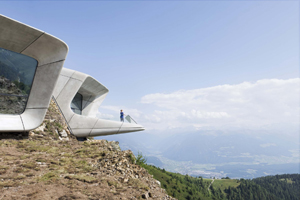 Zaha Hadid explains the concept of the design: “The idea is that visitors can descend within the mountain to explore its caverns and grottos, before emerging through the mountain wall on the other side, out onto the terrace overhanging the valley far below with spectacular, panoramic views.” Zaha Hadid explains the concept of the design: “The idea is that visitors can descend within the mountain to explore its caverns and grottos, before emerging through the mountain wall on the other side, out onto the terrace overhanging the valley far below with spectacular, panoramic views.”
In 2003, the Concordia 2000 Peace Bell was the first cultural installation to join the sports and recreational amenities at the summit of Mount Kronplatz, which include facilities for hang-gliding and paragliding, the Kron and Gipfel Restaurants, a replica of a Native American settlement, as well as the summit stations of the Kronplatz 2000 cable-car to Riscone/Reischach, the Olang cable-car to Valdaora, and the Ruis cable-car to San Vigilio. The Mountain Museum will welcome visitors throughout the year to explore Messner’s world where humanity is pushed to its limits, adding a further cultural and educational institution to Mount Kronplatz.
Reinhold Messner’s vision for a museum of submerged into the peak of Mount Kronplatz detailed three very specific locations of where the museum should emerge from ground: “In the first, a window looking out southwest to the peak of the Peitlerkofel mountain, in the second, another window should look south toward the Heiligkreuzkofel peak, in the third, a balcony should face west to the Ortler and South Tyrol.”
Informed by the shards of rock and ice of the surrounding landscape, concrete canopies have been cast in-situ and rise from the ground to protect the museum’s entrance, viewing windows and terrace.
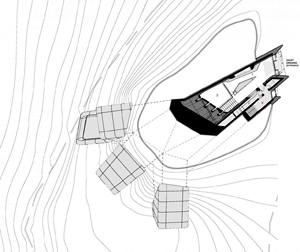 Reflecting the lighter colours and tones of the jagged limestone peaks of the surrounding Dolomites, the exterior panels are formed from a lighter shade of glass-reinforced fibre concrete and fold within the museum to meet the darker interior panels that have the luster and colouration of anthracite found deep below the surface. Reflecting the lighter colours and tones of the jagged limestone peaks of the surrounding Dolomites, the exterior panels are formed from a lighter shade of glass-reinforced fibre concrete and fold within the museum to meet the darker interior panels that have the luster and colouration of anthracite found deep below the surface.
A series of staircases, like waterfalls in a mountain stream, cascade through the museum to connect the exhibition spaces and describe visitors’ circulation over three levels. At the lowest level, visitors pass the viewing windows as they traverse through the galleries to emerge out onto the terrace that projects 6m from the mountainside giving a 240 degree panorama across the Alps.
At 1,000 square meters, the museum is arranged over several levels to reduce its footprint. During construction, 4,000 cubic meters (140,000 cubic feet) of earth and rock was excavated and then replaced above and around the completed structure – immersing the museum within Mount Kronplatz and helping to maintain a more constant internal temperature. The wide windows allow natural light to penetrate deep within the museum, drawing visitors forward through the interior to the panoramic windows and viewing terrace cantilevered over the valley far below. |
|
 |
 |
 |
 |
 |
 |
 |
VIDEO |
 |
|
|
 |
|
 |
 |
 |
| |
 |
|
 |
 |
 |
 |
MATERIALS |
 |
|
|
 |
|
 |
 |
 |
 |
 |
|
reinforced concrete, glass  Constructed from in-situ reinforced concrete, the museum‘s structure has walls between 40-50cm, while its roof supporting the replaced earth and rock that embeds the museum into the mountain, is up to 70cm thick. Constructed from in-situ reinforced concrete, the museum‘s structure has walls between 40-50cm, while its roof supporting the replaced earth and rock that embeds the museum into the mountain, is up to 70cm thick.
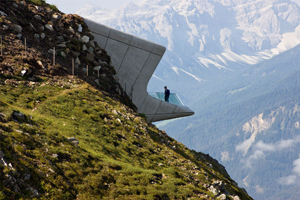 The majority of the museum’s exterior and interior panels are also made from in-situ concrete, with a formwork of tapered surfaces used to generate the peaks and abutments of the exterior panels that convey the rock and ice formations of the surrounding landscape. Almost 400 internal and external panels were prefabricated, with the more complex curved elements created in a process of spraying layers of high-performance fibre-concrete into moulds carved from CNC-milled foam using the architect‘s 3D model. The majority of the museum’s exterior and interior panels are also made from in-situ concrete, with a formwork of tapered surfaces used to generate the peaks and abutments of the exterior panels that convey the rock and ice formations of the surrounding landscape. Almost 400 internal and external panels were prefabricated, with the more complex curved elements created in a process of spraying layers of high-performance fibre-concrete into moulds carved from CNC-milled foam using the architect‘s 3D model.
A scaffold of steel sections with adjustable brackets to offset tolerances forms the museum’s substructure. Counter-plates for the connecting brackets are laminated directly within each panel during the prefabrication process.
|
|
 |
 |
 |
 |
ECO-SUSTAINABILITY |
 |
|
|
 |
|
 |
 |
 |
| Environmental impact |
 |
|
 |
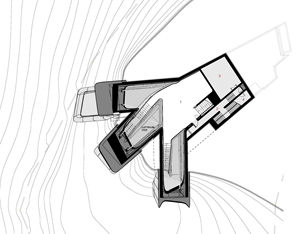 The architecture is unique. Walls, ceilings, and also architectural elements that are visible from the outside, such as the entry area, the panorama terrace and the panorama windows, are being encased with special ready-made concrete sections through the use of specially provided metal subconstructions. The architecture is unique. Walls, ceilings, and also architectural elements that are visible from the outside, such as the entry area, the panorama terrace and the panorama windows, are being encased with special ready-made concrete sections through the use of specially provided metal subconstructions.
The museum is laid out to a large extent underground on several levels, which is why at 1,000 square meters (11,000 square feet) construction is taking place on a comparatively small footprint. But 4,000 cubic meters (140,000 cubic feet) of earth have been moved. Thanks to this method, the museum keeps a constant temperature level in both summer and winter and thus is energy-efficient. |
|
 |
 |
 |
 |
 |
 |
 |
LOCATION |
 |
|
|
 |
|
 |
 |
 |

|
 |

|
Continent |
|
 |
|
Nation |
|
 |
|
Region |
|
 |
|
Province |
|
 |
|
Town |
|
 |
|
Hamlet |
|
 |
|
Place |
|
 |
|
Address |
|
 |
|
|
|
 |
|
Telephone |
|
 |
|
Website |
|
 |
|
E-mail |
|
 |
corones@messner-mountain-museum.it |
|
 |
 |
 |
 |
MAP |
 |
|
|
 |
|
 |
 |
 |
| |
 |
|
 |
 |
 |
 |
|
TYPOLOGY |
 |
|
|
 |
|
 |
 |
 |
|
|
 |
ARCHITECTURE | Museums and buildings for exhibitions
Natural history museums
Urban equipment and structures for public areas
Panoramic structures, belvederes
| |
 |
 |
 |
 |
CHRONOLOGY |
 |
|
|
 |
|
 |
 |
 |
Project |
 |
|
 |
| 
 |
2013
|
|
Realisation |
 |
|
 |
| 
 |
2014 - 2015 |
|
 |
 |
 |
 |
AWARDS |
 |
|
|
 |
|
 |
 |
 |
| 2017 |
 |
|
 |
Premio Andrea Palladio
Italia
|
|
 |
 |
 |
|
 |
|
| 2016 |
 |
|
 |
KlimaHaus / CasaClima Awards
Premio Speciale |
|
 |
 |
 |
 |
 |
 |
 |
THE BUILDING IN CINEMA |
 |
|
|
 |
|
 |
 |
 |
| Title |
 |
|
 |
| Un passo dal cielo - Il volto del demone |
|
| Directed by |
 |
|
 |
|
| Nationality |
 |
|
 |
|
| Year of production |
 |
|
 |
|
| Cast |
 |
|
 |
| Daniele Liotti, Enrico Ianniello, Francesco Salvi, Rocio Munoz Morales, Gianmarco Pozzoli, Tommaso Ramenghi, Pilar Fogliati, Alice Torriani, Caterina Shulha, Matteo Martari, Daniela Virgilio, Francesca Piroi, Cristina Marino, Pia Engleberth, Alberto Molinari |
|
| Building's role |
 |
|
 |
|
| Annotations |
 |
|
 |
TV series.
Season Four, Episode 18. |
|
 |
 |
 |
 |
 |
 |
 |
THE BUILDING IN ADVERTISING |
 |
|
|
 |
|
 |
 |
 |
| Product |
 |
|
 |
 |
TIM Impresa Semplice |
|
|
|
|
 |
 |
 |
| Company |
 |
|
 |
|
| Agency |
 |
|
 |
|
| Directed by |
 |
|
 |
|
| Music |
 |
|
 |
| Jeff Buckley [Last Goodbye] |
|
| Testimonial |
 |
|
 |
|
| Aired |
 |
|
 |
|
| Building's role |
 |
|
 |
|
 |
 |
 |
|
 |
|
 |
 |
 |
 |
BIBILIOGRAPHIC REFERENCES |
 |
|
|
 |
|
 |
 |
 |
|
 |
"Continua l'impegno nella promozione degli edifici sostenibili", CasaClima DueGradi 2, ottobre 2016, pp. 10-30
"Premio Speciale. MMM Corones", CasaClima DueGradi 2, ottobre 2016, p. 30 (10-30) |
|
|
| Sabine Schneider, "Reshaping a mountain", Topos 93, december 2015 [Fragile Landscapes], pp. 54-59 |
|
|
| John Jervis, "Messner Mountain Museum", Icon 148, october 2015, pp. 58-62 |
|
|
| Edith Schlocker, "Messner Mountain Museum am Kronplatz. Schwungvolle Entschleunigung / Messner Mountain Museum on the Kronplatz. A sweeping deceleration", Architektur Aktuell 427, oktober/october 2015, pp. 114-124 |
|
|
| Herbert Wright, "A cut above", Blueprint 342, september-october 2015, pp. 204-2018 |
|
 |
 |
 |
 |
 |
 |
 |
CLIENT |
 |
|
|
 |
|
 |
 |
 |
| |
 |
|
 |
 |
 |
 |
DIMENSIONAL
DATA |
 |
|
|
 |
|
 |
 |
 |
| Surface |
 |
|
 |
|
| Share |
 |
|
 |
|
 |
 |
 |
 |
STRUCTURES |
 |
|
|
 |
|
 |
 |
 |
| |
 |
|
 |
 |
 |
 |
STAFF |
 |
|
|
 |
|
 |
 |
 |
Project  |
 |
|
|
 |
|
|
 |
|
Design |
 |
| Zaha Hadid with Patrik Schumacher |
|
Project architect |
 |
|
Design team |
 |
| Cornelius Schlotthauer, Peter Irmscher |
|
Executive architect |
 |
| Peter Irmscher, Markus Planteu, Claudia Wulf |
|
Mechanical engineer |
 |
|
Electrical engineer |
 |
|
 |
 |
 |
 |
RELATED PROJECTS |
 |
|
|
 |
|
 |
 |
 |
| |
 |
|
 |
 |
 |
 |
CREDITS |
 |
|
|
 |
|
 |
 |
 |
| |
 |
Photos © Werner Huthmacher, Luke Hayes, wisthaler.com, inexhibit.com
Drawings © Zaha Hadid Architects
Text edited by Reinhold Messner, MMM Messner Mountain Museum, Zaha Hadid Architects
Videos © MMM Messner Mountain Museum, Zaha Hadid Architects
Courtesy of MMM Messner Mountain Museum, Zaha Hadid Architects
|
|
 |
  |
 |
|
|